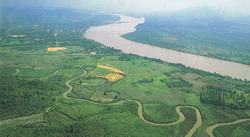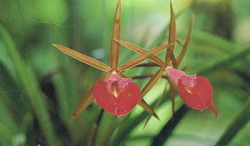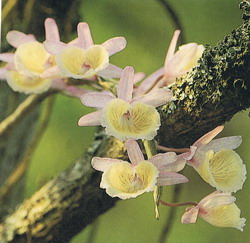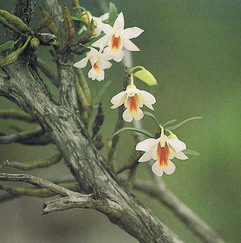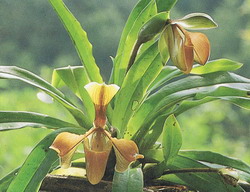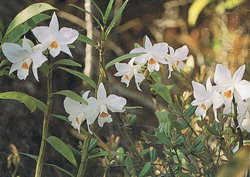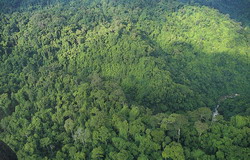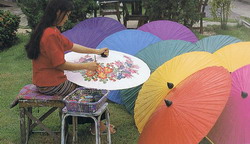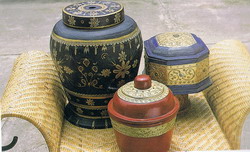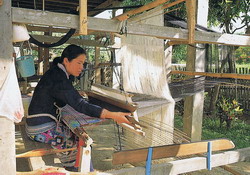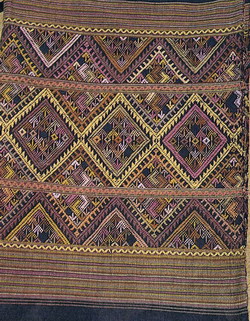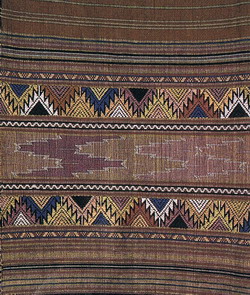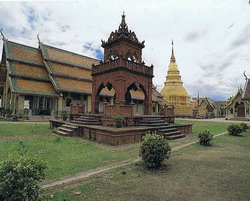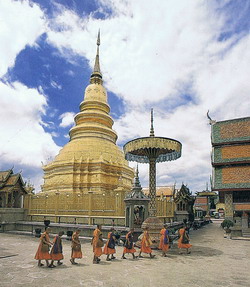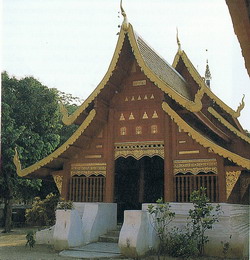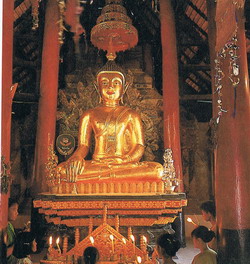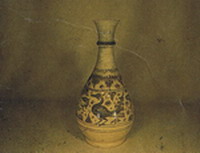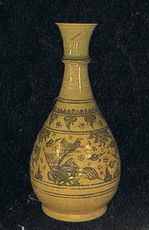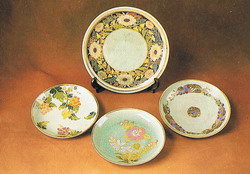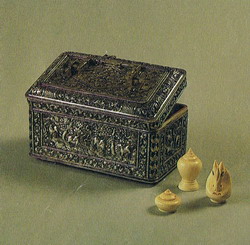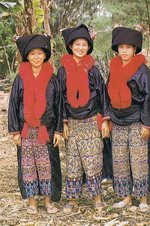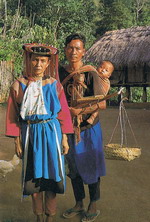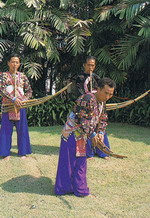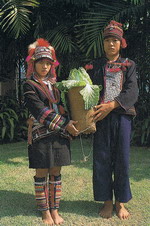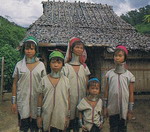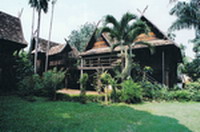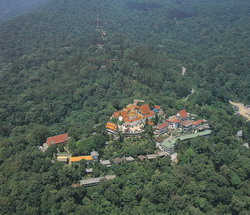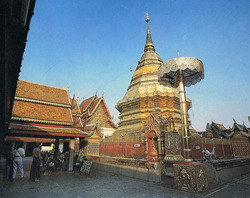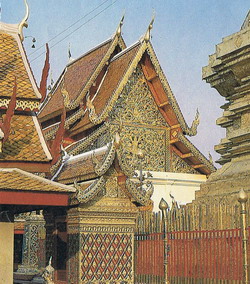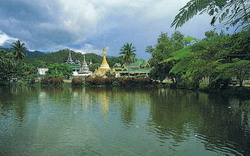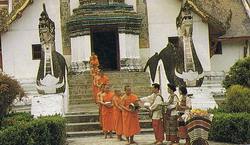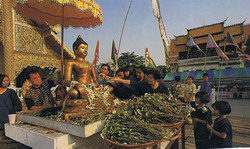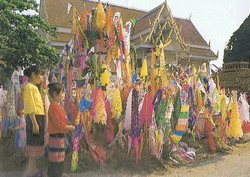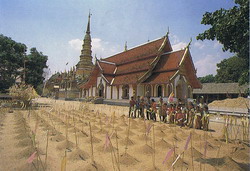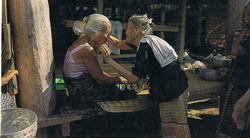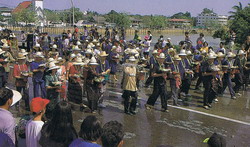
Search
 Custom Search
Custom Search
Cultural Landscape of the Northern Region of Thailand Geographical Setting Physical characteristics
The northern region of Thailand covers the 8 provinces of Chian Mai, Lamphun, Lampang, Chiang Rai, Phrae, Nan, Phayao and Mae Hong Son with an area of 170,000 sq.km. The region has a tropical climate. Geographically, the region consists of mountains and high hills around various mountain basins. The mountain ranges stretch from northeast to northwest and from north to southe. High mountain ranges are located mostly in Chiang Mai, Lamphun, Lampang and Mae Hong Son. They are the sources of major streams such as the kok, Ing and phang which drain into the Mekong, and the Pai and Yuam which drain into the Salawin of Myanmar. These mountain ranges are also the headwater of the Ping, Wang, Yom and Nan.
The northern region can be geographically categorized, according to elevation, as follows: 1. Plains. This is the area with an elevation of less than 30 meters above the waterbed. The soil composition is mainly silt, coarse sediments, clay and porous soil. The plains lie along the river banks between 100 to 400 meters above sea level. They are suitable for agricultural purposes, especially for irrigated rice producttion. The plains amount to 11% of the entire northern region.
2. Hilly Plains. This is the area with an elevation of 350 - 500 meters above sea level. They are terraced hills of old sediment, coarse porous soil or gravels soil composition suitable for cash crops, orchard or rainwater rice production. 3. Uplands. This is the area between the hilly plains or terraced plains and the mountain ranges. The elevation is between 150 - 600 meters above the waterbed. The soil combination is of porous soil and rocks suitable for growing corn, cotton and cassava. Forests are found in some upland sections. They cover 19% of the total area of the region.
4. Highlands and mountains. The elevation is from 500 to 2,000 meters above sea level. Certain parts of these areas are granite-based and contain various valuable ores such as tin and lead. They make up 42% of the region's total and contain the head waters of many streams and rivers which prvide for the production of temperate cash crops, fruits and vegetables. Forests
The forests of the Northern region can be divided into 5 major categories. 1. Rainforests found in the highlands and mountains up to 1,000 meters in altitude. 2. Pine Forests found in the altitudes of more than 1,000 meters above sea level. 3. Tropical Broadleaved Seasonal Evergreen found in an elevation of 700 - 1,000 meters.
4. Deciduous Forests which consist of 3 sub-categories of Humid Deciduous, Dry Deciduous and Lowland Deciduous. The prominent type of forest is reak. 5. Dry Dipterocarp or Deciduous Dipterocarp. Found mostly in areas not more than 750 meters above sea level with infertile soil compostion of gravels, rocks or laterite. Rivers The major river basins of the North which make up 75% of all Thailand's river basins are:
1. The mekong basin, the area north of Chiang Mai, Chiang Rai, and Phayao which are fed by the Fang, kok, Maelao and Ing Rivers which drain into the Mekong. 2. The salawin basin, consisting or streams and rivers originating from the western mountain ranges, the major ones are the Pai and Meoy which flow into Salawin in Myanmar. 3. The Ping basin, the areas of the Ping's tribuaries which are the Maetang, Ngat, Tha, Khan, Jaem, Kuong, Lee and Namwang Rivers. 4. The Wang Basin, areas covering the Lampang plains which are fed by the Maewang, Tho, and Tui. These major tribuaries join the Ping in Tak province.
5. The Yom basin. The maelao and Fakadarn rivers run through Sukhothai region and flows into the Nan River in Nakhon Sawan. 6. The Nan basin, originating in the Luang Phrabang range in the North with the Namwang, Nam-ngang and Nampart as major tribuaries. The Nan River merges with the Ping in Nakhorn Sawan.
The southwestern monsoons from the Indian ocean bring rains to the region from mid-May to September. There are ocaional tropical storms from the Pacific and the South China sea which cause heavy rainfalls in the bains. The amount of rainfall varies, affecting patterns of agricultural production in different areas. The highland plains rely mostly on rainwater. Together, the 8 major basins of Ping Wang, Yom Nan, Pasak, Mekong, Salawin and Sakaedrang provide almost 40,000 million cubic meters of ground level water annually. 90% of rain falls in the 7 months period of May to November, another 10% falls in the other 5 months during which droughts usually occur. Because of this great variation in the levels of rainfall, the northern villages have, for centuries, developed systems of dykes using wood and bamboo for the storage and distribution of water. More durable iron-reinforced concrete dikes and gates were subsequently introduced in many irrigation projects. A number of dams were also constructed for the generation of electricity, for example, Phumiphon Dam on the Ping River and Sirikit Dam on the Nan River.
Minerals Geologically, the northern region's landscape is composed of ancient sedimentary focks, igneous rocks and granite which produce numerous ores such as tin, tungsten, wulfram, fluouride, gemstones, copper, lead, zinc, barite, nickle, chromium, manganese, phosphate, feldspar and kaolin. There are also petroleum and lignite which are important sources of fues for the generation of electricity as well as geysers in Chiang Mai and Chiang Rai. Populations and lifestyles
The total population of the 8 northern provinces combined was 6 million in 1995. They come from different ethnic groups, the largest one being the Thai Yaun or Thai Yonok which sgare a common language of Lanna Thai, and live in the basins of Chiang Mai, Lamphun, Lampang, Chiang Rai, Phrae and Nan. Teh second largest ethnic group is the Tahi Keon of Chiang Mai and Chiang Rai. The third group is the Thai Yai or Thai Nueo in the Salawin basin in Mae Hong Son and the Mekong basin of Chiang Rai. the fourth ethnic group is the Thai lu which migrated from Sipsongphanna in the Yunnan province of China and from the town of Yong in Chan State of Myanmar. The majorrity of Thai Lue settled in Nan, Chiang Rai, Phayao, Chiang Mai and Lamphun.
In the higher altitude regions there are a number of indegenous minority groups. The Karens live along the borders between Thailand and Myanmar and some have moved to Chiang Mai and Lamphun. The Austronesian ethnic groups of Lawa or Lao, Chin, and Kamu whose ethnicity are similar to the Mon and Khmer are also present as well as the Hmong who migrated from China.
The mountain areas of medium altitudes are the residence of the Lahu and Lisu which belong to the Tibeto-Burman groups. They prefer to build their houses near water sources. On the higher altitudes of more than 1,000 metres, live the Akha. All of these hill tribe minority groups are scattered over the mountain ranges in almost every northern province. Other minority groups living in the northern plains are the Chinese, Indian, and those European of descent. All three groups are involved mostly in trade, service and the industrial sectors. Most of the Chinese, after many generations in the country, have now assimilated and become Thai citizens.
ways of Life The northern way of life is known as the "Khon muang" or "Lanna" culture. The latter word was coined after the ancient nation state found by King Mengrai in the 18th Buddhist century. The capital of this kingdom was called "Nopaburi Srinakhonphing Chiang Mai". Different indigenous cultures of the kingdom are bound together by the common traditions of agricultural lifestyles, Theravada Buddhism, animism, and ancestor worship practices which involve the concept of "ghosts" or spirits. Other common features of the "Khon Muang" culture are ideological and emotional expressions through language, literature, music and crafts.
The plains and basins of the northern region can support many types of agricultural activities such as the production of rice, cash crops and fruit orchards, but their potential is limited by the scarcity of fertile lands and an increase in population. There problems are solved by the construction of more dams and natural water reservoirs which provide water all year round and enable the farmers to increase production in the existing lands by growing multiple crops. Other measures that have been introduced to increase the amount of fertile land are irrigation projects which improve the quality of land in the destroyed forests and on the hill slopes as well as the introduction of new varieties of plaings. Experimental farming of temperate vagetations is also possible because of the cold climate of the North. The hill tribe people are having considerable success with the replacement of opium production with flowers, fruits and vegetables. Due to the fact that the prices of these products are too high for the consumption of the local people, they are sold mainly to tourists, Bangkok and overseas markets.
Animal husbandry of pigs, chickens, cows and buffaloes is traditionally practiced on a small scale within living compounds. Large scale chicken and dairy farms have recently been introduced in the inter-mountain plain areas. A large number of stream and rivers provide natural fishery sources. The government has introduced commercial framing of fish and prawns in ponds as well as increasing the natrural stocks by artificial breeding of fish and prawn larvae and releasing them to natural waters. People who live alongside these dams can also supplement their income by fishing. Another important occupation of the northern region is logging, especially teak logging. Transportation of logs through rivers to cities in the Central plains in the past has been replaced by road transportation and the establishment of mills in the region. An increase in population and a demand for more wood consumption lead to illegal logging and large scale destruction of forests. The government has taken a leading role in feforestation but demand still far exceeds supply, and it is necessary that other types of materials be utilized instead.
The availability of many minerals makes mining an important occupation in the North. Since the Second World war, conflicts between miners and farmers have increased as wasted materials and water from mining increasingly contaminate farming water su;;ly. There are also disputes about droughts caused by mines in the highlands withholding water for their own use and ruining lowland crops in the process. Although agriculture has long prvided the nothern people with adequate means of subsistence, lower prices of agricultural products put farmers at disadvantage. The government is, therefore, actively involved in ghe promotion of industrial development in this region as well as in the rest of the country.
There are no smelting or other heavy industries associated with mining in the Norht because most ores produced in the region are sold as raw products overseas. The only existing industry in the region is agricultural-based, involving the production of canned and frozen fruits and vegetables. This industry is faced with problems of unstable supply and low quality of raw materials. Well-known industies in the North are small scale or cottage industies in the crafts of weaving, ceramics and earthenware products, silverware, lacqueredware, wood carving, and clothing. These industries cater to tourist and local markets and have only recently expanded into the export business. Following the government's promotion of the tourist industry, tourism has become a major source of income as the regions are well-endowed with beautiful landscapes, exotic traditions, famous ancient ruins, and an interesting supply of folk crafts for souvenirs.
Beautiful scenery and climate have contributed to a recent increase in building industries providing business and private residential housing projects for the major cities of Chiang Mai and Ching Rai. Such projects also generate work and income for the local population.
Culutral components : Material Culture and Non-material culture Material Culture consists of food, health care tradition and housing food Teh highlands and inter-mountain plains bring the northerners in close association with the forests and influence their food habits. They have experimented with forest vegetation in their menu and in the prepration of herbal medicines. Northern style dishes are famous for their use of numerous vegetables unique to the region. Sources of protein in the food come mainly from chickens, cows, buffaloes, pings, fish and insects. Meat is regarded as special-occasion food prepared in many different ways both raw and in cooked dishes.
Glutinous rice is the standard staple consumed with the fingers with every dish. Meals are taken from a low wooden tray called "Khantok" which is large enough to hold all the dishes prepared for each meal. People take their meal from the tray, sitting on the floor. The food of the hill tribe people comes mainly from the forest and their gardens. Their main staple is "Khaorai" or highland rice which is very similar to paddy rice. Popular garden vegetables are corn, letuce, sesame, tomato, barley, and chilli pepper. Kharen and Akha food is cooked with chilli and herbs while the Hmong, Lisu and Yao prefer blend, boiled or fried food. For the Akha, the second major staple after rice is corn. Most hilltribe people raise pigs for food and for ceremonial meals. The Karen prepare rice and boiled chicken in the New Year ceremony organized for the ancestral spirits. A large amount of "Ofu" or seamed glutinous rice crushed and mixed with sesame is also prepared for the occasion. The Akha prefer pork to beef. They also kill pigs during the New Year period and distribute the pork and "Ofu" to their neighbors.
|
Click Here!
|
Traditionally, Thai people of all groups share similar of dress with variations only in the details of accompanying adornments and the users of garments. Originally woman wore "phasin" or long wrap-around skirts with or without blouses depending on local climat. Men wore a wrap-around piece of cloth which could be left long or pulled up between the legs to form a kind of pants. Later the men switched to Chinses and subsequently European type pants. In the palst, shirts were made of simple rectangular pieces of cloth, and Indian. Chinese and European style shirts were adopted later. The Lanna Thai adopted the practices of wearing shirts and pants after the reign of King Rama V.
Women's skirts vary in color between different groups. Dyeing materials were collected from plant parts or animal products. Health care tradition Traditional doctors believe that diseases are caused by the disruption of the balance among 4 major body components of earth, water, air and fire. The situation can be remedied and the balance restored by the use of herbal medicines in conjunction with curing rituals designed to give the patiens moral support. There are various types of herbal medicine for various purposes. The medicine usually consist of different herbs boiled in water, ground or steamed.
Housing Northern style houses are wooden houses raised on stilts. Traditional Lanna houses can be divided as follow:
1. "Toob" or ruen krueng pook. This style of house is made mainly of bamboo. The walls are made from dried grass leaves. This is a house frames are held in place by locking or tying different pieces together. Roofing materials come from dried grass leaves. This is a temporary house erected in gardens or rice fields by poor people or small families just starting out. It lasts between 2-4 years.
2. Wooden house or ruen krueng sup. It is made of a combination of soft and hard wood which was abundant in the North. All the frames and major structure of the house are made of hardwood while loft wood was used for minor parts. This type of house can last 30-50 years. In general, the houses face the south to catch the summer wind. The kitchen faces the west to protect the bedroom from the afternoon sun. The housing compound consists of at least a living quarter and a kitchen connected by walkways and terraces. The largest terrace is for drying clothing, fruits and vegetables. Potted plants such as flowering plants, parsely, shallot and pepper chilli etc. are also kept in this part of the house.
3. Ruen Galae. This type of house belongs to the rich, the community leaders and the elite. Galae refers to the roof beams at the front and the rear of the house extended beyond the ridgepole to form a V-shaped design. The prominent feature of this style of house is the elaboratedly-carved sections of the Galae. The houses are built with the best materials and craftsmanship. Components of the northern house.
1. Beedroom. This can be closed for privacy. 2. "Teon" or veranda. It is a hall in front of the bedroom which is used for resting, receiving visitors or having meals. This section is raised to 20-30 centimeters higher than the terace. 3. Terrace. This is the open area for walking, storage or weaving activities. 4. Kitchen. This is the food preparation and cooking area. 5. Storage. This is the shelving section above the bedroom. Another storage section is found above the cooking area.
6. "Raannam"> A raised platform in the terrace area about 1 meter high is built to house a drinking earthenware pot which can keep the water cool. 7. Stairs. The stairs are always situated to the north or south of the house, stairs facing the West are avoided for fear of misfortune. The number of stairs are usually odd. The Lanna Thai house is generally situated among fruit trees for shade. Spaces are left between the houses for children's playgrounds and the drying of agricultural products.
The house grounds are always kept clean. There are bamboo fences for edible vines as well as vegetable plots or potted herbs and spices for kitchen use. Each house grows orchids for flowers and bamboos for their shoots and for handicraft materials. The house compound is example of serene cohabiation with nature. Dogs are popular pets, which are kept tied to a special post next to the stairs. In the past, wells were lined with bricks and raised about 1 meter above the ground. Surrounding the wells are flower plants, trees and a small bath house.
Close to the house is a granary raised on stilts with a veranda on all 4 sides. These verandas are used for the storage of rice-growing equipment. The granary has no stairs. Movable stairs are provided only when the rice or equipment is needed. The location of the housing compound is of utmost importance. Serious consideration is given to appropriate directions, the auspicious one being the East. Lnad elevation, nearby location of anthills, ponds, rivers and large trees are considered in conjunction with the chosen directions. Suitable trees believed to bring good luck must be planted in certain directions around the house. Transgression against these observations are believed to be "Khud" or evil and will bring about ill health or misfortune to the residents. Non-material Culture Lanna Thai beliefs and taboos
The following are examples of major elements in the Lanna Thai belief system. 1. Buddhist Belief system. Lanna Thai Buddhism comes from various sources and is closely intertwined with animistic and Brahmanic belief and rituals. 2. Beliefs in magic. Lanna Thai people holdn strong beliefs in mystical power, magic and sacred objects. These elements are present in one of the Brahmanic texts which is reflected in most literature which mentions the relationships between Gods and men and the contest between good and evil. There are also beliefs in paradise as the place of ultimate bliss and hell as the pit of tormented souls. 3. Beliefs in astrology. Most Lanna Thai people believe in having their future read by astrologers and fortune-tellers. This also leads to the beliefs in auspicious times, fate and dreams. There is also a strong adherence to many taboos and observations for fear of bad luck. Beliefs in spirits Ancestor spirits and rituals
Phi Puyatayai or ancestor spirits are believed to reside in a small abode set up at the head of the bed. This abode is built in the shape of a small house about 1 meter wide and 1 1/2 meters long with a raised shelf containing various offerings. Special rituals are performed for the Ancestor spirits when a member of the household is sick, gets married or on special merit-making occasions. Phi Chaonai or spirits of the Gods are ranked by their status and can be contacted through a spirit medium during the New Years celebration and on other occasions. The Gods are appeased through food, dring and dance. Other types of spirits are :
1. Spirits of the village. They protect the villagers ffrom danger and misfortune and reside in a sacred zone, uaually old trees. The annual feast for the village spirits is the occasin for a grand celebration. 2. Spirits of the rice-fields. These are the guardian spirits which ensure that the water and fish are abundant, the animals are in good health and the fields provide high yields. They reside in a corner of the fields which are raised higher than the others. Offerings are given to the spirits before the fields are tilled. 3. Ancestos' spirits. These are spirits of deceased relatives which have not yet been reborn and dwell on to protect their children. Sickness in the family signals the wrath of the ancestor spirits for any inappropriate behavior of the descendants. It is a custom to make merit on behalf of the ancestor spirits on certain Buddhist holy days.
4. Phii-pop or Phi-ka. These spirits are believed to enter the body of a living person to consume their inner organs which may lead to the death of that person. Only specialists with magical power can make the spirits leave the body. It has been noted that in most cases of Phii-pop possession the patients are already sick, unhealthy and of weak mind. Agricultural tradition The northerners have always maintained a close connection with agricultural ways of life which center around the rice-growing cycle which starts in June or July with the preparation of rice seedlings in small plots. Next is the first "hack", opening or tilling, of the ground which has to be done in a certain fashion strictedly regulated by traditions. Prior to the first opening of the fields for the season, the owner of the fields and his family gather to give offerings to give offerings to the Land Goddess.
When the rice matures the farmers organize work parties which take turns harvesting the fields of reach member of the party. Before the threshing of the paddies farmers arrange another ceremony to express their gratitude to the Rice Goddess. The cycle ends with the threshing and winnowing of the paddies. Language and literature The northern dialect is known by various names such as Lanna language. Northern or Northern Thai language. Kham muang or Kham muang language. It is spoken in the upper part of Thailand. Both Kham muang and standard Thai share similar systems of alphabet, vowel and intonation sounds with only slight variations in certain sounds. There are two sects of Kham muang alphabets. Fackham and local alphabets or Tau muang. The latter is also known as Tua tham or Dharma language. The local alphabets are similar in appearance to the Mon and Burmese languages reflecting political and social domination of the two nations in the North. At present, there is a large number of palm-leaved texts written in the local language which contain valuable information on social, political, administration, art and culture of the northern region.
There are two types of local literature: 1. Oral tradition. This type of literature is transmited through oral communication in the forms of conversation, teaching, songs, folktales, sayings, quotations, riddles, courting verses and speeches. 2. Written traditions. The Lanna Thai written traditions are produced in a number of ways. 1) Literature related to Buddhism. This group of literature is written in verse form, by Buddhist monk-scholars. They are regarded as sacred texts. 2) Literature related to teaching, tradition, ritual and belief system. They are books on astrology, magic practices, rice-growing ceremonies, charms and amulets. The authors are Buddhist monks and experts on the subjects. Many are copied and passed down from generation to generation. They are also sacred books which require special rituals in their production and reproduction.
3) Literature related to secular matters. The authors wre scholars of Lanna language and because romance and passing are the subjects of literature in this group the majority of the authors are experienced laymen. 4) Love messagers written by both men and women who have knowledge of the Lanna language. It is apparent that Buddhist temples are the most important source of knowledge. Social and cultural changes
The northern region has undergone a lot of social and cultural changes which introduce such technological development as road,. railway and air transportation. Other changes are the constuction of dams for irrigation and electricity, factories, shpping malls, tertiary educational institutes and hospitals. Nevertheless, these developments are still influenced by the region's physical features. People are still engaged in agricultural activities in the inter-mountain basins with major cities situated along important rivers. Economic development has altered the villages' social structure foloowing the changing patterns of land-use, which convert agricultural areas into industrial, residential and tourist business sections. The region has become more urbanized with more and more villagers leaving the fields for wage-work in factories, the tourist and service businesses.
|
||||||||||||||||||||||||||||||||||||||||||||||||||||||||||||||||||||||||||||||||||||||||||||||||||||


